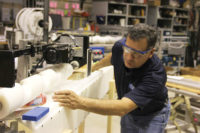
Consistent infeed of particles allows precision discharge when materials are pneumatically knifed off from the vanes of the rotary scalpel metering feeder. Source: 3i’s Technologies.
Mergers, downsizing, outsourcing-there are multiple corporate events that translate into layoffs of process engineers, particularly those of a certain age. The financial math often doesn’t add up for middle-aged workers, and many of these professionals either drift into alternative employment or are pushed into premature retirement. Occasionally, however, entrepreneurial inspiration intervenes, and skilled professionals are free to develop new technologies.
In effect, that’s what is happening at 3i’s Technologies, a firm incorporated in August 2008 and populated with former employees of K-Tron Technologies, a manufacturer of feeders and vacuum-conveying equipment. K-Tron started shedding workers when the US economy headed south, ultimately being acquired by Hillenbrand Inc. in January. Some of the employees found a home with 3i’s, whose founder, John Pettit, had left K-Tron a decade earlier. This additional engineering brainpower has allowed Pettit to move beyond process consulting to development and fabrication of equipment to fill niche needs. The first fruit of this collaboration is the rotary scalpel metering feeder, which debuted in May at PTXi (formerly the powder & bulk show).
An electrical engineer, Pettit joined K-Tron after earning a bachelor’s degree from Philadelphia’s Temple University. At K-Tron, he served in a variety of capacities, including sales, marketing and engineering. His particular expertise lies in gravimetric and volumetric feeding and their role in process improvement.

John Pettit, president, 3i’s Technologies, Vineland , NJ .
Pettit: We’re focused on controls integration and process improvement, identifying ways to deliver greater value from equipment than it is set up initially to deliver. You can do your best integration work when working around a technology like batch feeders and fillers for granular materials that you know very well, and that’s where we focus. I’d just as soon buy someone else’s equipment and optimize it, but when we evaluated the precision of feed systems, we saw an opportunity to improve precision. That led to the rotary scalpel metering feeder.
FE: How did the unit come about?
Pettit: We were testing various bulk metering devices last August, seeing what kind of improvements we could make, when I came up with the idea. All of the feeder systems-rotary, screw, belt, vibratory-were based on smaller and smaller constrictions in the inflow. Many materials compress and don’t like that. Finally I asked, what would be the perfect world? A complete separation of the infeed and the discharge seemed to be the answer. The next day, Glenn [Meredith, a mechanical engineer and former K-Tron colleague] and I were playing around with crude prototypes. Within three weeks, we could see that the concept was sound and built two more prototypes on the way to the final design.
FE: How does scalpel metering feeder work?
Pettit: Typical feeders either dribble material inconsistently, resulting in overfeeding and waste, or deliver the same metered amount each time. The rotary scalpel is dynamic: Material flow into the vanes of the rotating drums is constant, and once the dribble setpoint is calculated, the precise amount is knifed off by the pneumatic scalpel, delivering a precise amount to the outlet. If the density of the material were 40-50 lbs. per cu. ft., each vane would hold 25-30 grams. If the density were 15 lbs. per cubic ft., the resolution of control would be even better.
FE: What were some of the development issues?
Pettit: After the initial concept was proven, every time we went from one prototype to the next, there were unintended consequences that caused us to take a step back. In bulk material handling, there are subtle differences in what works and what doesn’t, and you’re always faced with adjustments.
FE: What was one of the unintended consequences?
Pettit: At one point, the inlet was part of the machine, but we found that this limited the types of materials that could be accurately metered. By designing a large inlet that was an independent component, we found we could ensure more consistent flow for a wider range of materials. For large particles, for example, breath mints weighing a gram each, we can meter out individual particles in each vane of the rotary feed drum. Flexibility of design was fundamental to the project.
FE: How many moving parts does the unit have?
Pettit: Three. The device that does the most and has the least is the best invention, isn’t it? Simplicity of design was also a goal, and we tried to minimize the number of parts and the amount of movement. The friction of the rods, or fill vanes, is a potential point of failure, and the size of the rods can be scaled up if necessary to keep the drum’s rotation between 1-15 RPMs.
FE: Is there anything exceptional about the controls?
Pettit: We used off-the-shelf software that’s not overly complex. The feed cylinder and scalpel are driven by low-power, high-torque stepper motors. In a batch mode, the dribble setpoint is calculated after a weight reading is recorded from the fast-delivery bulk feeder. The pneumatic scalpel is positioned and activated to knife off the precise amount of material required to complete the batch. As the next vane is filled, material remaining in the vane is discharged to the recycle chute and returned to the infeed.
What’s unique is the device’s ability to deliver a variable, finite volume of material as determined by the weighing system, whether it’s a gravimetric weight-loss batcher or a volumetric gain-in-weight scale system. Accuracy is expressed as a percentage of batch size, rather than a percentage of full-scale capacity. The larger the batch, the more precise it becomes: For a 1-lb. batch, accuracy is 0.11 percent; for a 100-lb. batch, accuracy is 0.0011 percent.
FE: Is food processing the most likely application?
Pettit: We introduced the rotary scalpel at the powder & bulk show because it draws a horizontal audience, and we wanted to see where the interest lies. People from several food companies stopped by the booth, and we think food and chemical will be strong markets, along with pharmaceutical and nutraceutical manufacturers.
FE: 3i’s also is introducing a device called a dynamic bulk density meter, though it wasn’t exhibited at the powder show.
Pettit: It was too big to bring, and we didn’t want the rotary scalpel competing for attention. The meter is basically just a concept, a way to maintain a specified density of a material and use it as the control variable in a blend of materials of varying density. The measurement is done in-line, in real time, by closing a gate valve in a pipe on a timed basis and triggering a weight reading at a defined level. Bulk density is calculated by dividing material weight by the volume of the material. We’ve used the system in conjunction with the bulk solids pump, a very precise volumetric feeder introduced six years ago by K-Tron (“Lilliputian principles of design,” Food Engineering, September 2004). I helped develop the bulk solids pump. This was an idea I had then, but it wasn’t pursued.
The density of multiple components in a product is important, but when there isn’t a practical way of measuring it, it’s ignored. A package could be the correct weight, but if it appears half- or two thirds-full, buyers feel cheated. Quality issues can occur, as well. Instant coffee’s taste is impacted by the blend of fine and course particles, so they need to be separated and then blended back to the desired density to create a consistent taste. The bulk density meter has targeted applications, but by making the tool available, we know researchers will find additional benefits.
FE: How does commercializing a technology like the bulk density meter compare when done by an entrepreneurial firm as opposed to a large organization?
Pettit: It’s tough to market a concept that’s a little out there and to show how this might benefit a technology like the bulk solids pump. But I’m trying to be a catalyst, and those who come out with innovation that makes a difference will be the ones who get rewarded. Innovation usually comes from smaller organizations that have a single focus, get things done in a short timeframe and don’t have as much risk as larger ones. A big company might devise a better mousetrap, but if it makes its money from selling mousetraps, that deters innovation.



